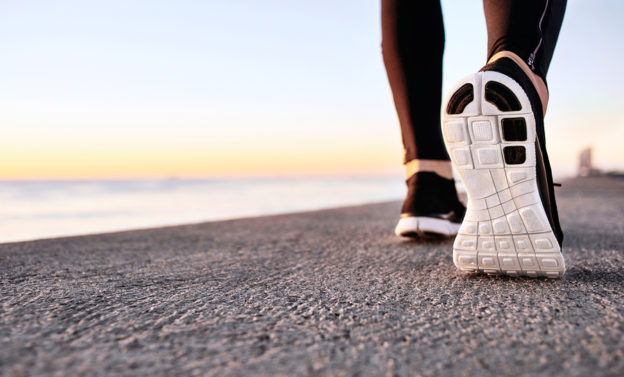By David Blyweiss, M.D., Advanced Natural Wellness
February 19, 2018
- Feeling weak and out of balance?
- How fast (or slow) you walk may predict longevity
- Unusual exercise boosts muscle and bone strength
Growing old gracefully is something everyone strives for. But sometimes life catches up with you faster than you realize.
The next thing you know, you’re feeling weaker than you would like. Your muscles and bones aren’t as strong as they used to be. And your risk of falls and fractures increases exponentially.
You might think this only happens to “old” people.
Well, believe me!
I’ve met plenty of patients in their 50’s and 60’s that are already experiencing muscle loss, balance issues and osteoporosis. As a matter of fact, about 40% of folks in this age group already have low bone mass in their hips or spine.
MD Exposes the Hidden Danger to Your Eyes

When your eyesight starts to fail, it's a real problem. Suddenly you can't go to the grocery store... you can't get to the doctor if you have an emergency... you can't meet your friends for dinner…
Your "regular" doctor doesn't have time to keep up with the latest research. And the same goes for eye doctors. They go to school to learn how to fit you for glasses and contacts, but have no way of preventing the damage and loss of eyesight that threatens your freedom and independence.
Let me show you something that explains a LOT about how your eyes work.
In my FREE Special Report, I'll show you a HUGE, untapped resource for your eyes that safely and naturally restores clear, effortless eyesight.
Click here to get started...
Once these types of problems rear their ugly head, it can literally steal away your livelihood.
Physical weakness can leave you feeling anxious about exercising and walking long distances. Even simple activities such as rising from a chair or stepping off a sidewalk can become difficult. Over time, it can leave you feeling pretty depressed about your future prospects.
As a result, it’s critical to prevent the onslaught of muscle and bone loss long before they occur. And if you’re already experience problems, it’s time to tackle them head so you can regain your strength and confidence.
How Fast (or Slow) You Walk May Predict Longevity
Here’s something I bet you’ll find interesting. Gait speed – the speed at which you walk – is actually a predictor of mortality.
Men and women with slow gait speeds have a 10-year survival rate of just 19% to 35%. In the meantime, those with the highest gait speeds have survival rates of 87% to 91% over the course of the next 10 years.
This is a huge difference!
And as amazing as it sounds, simply improving the rate at which you walk can increase your lifespan. Your chances of a longer lifetime increases exponentially for every 0.1 meter per second faster your gait speed increases.
The World's Quickest Solution for Ending Prostate and Urinary Misery
This has recently been revealed to be one of the only real breakthroughs in prostate health.
The seeds of a strange fruit (sometimes called "Chinese Apples") hold powerful phytonutrients that are a revolution in prostate health.
In fact, UCLA and Veterans Administration research have now proved this to be true.
Not only that, but it may be the worlds quickest solution for ending prostate misery.
Simply stated, these phytonutrients represent a huge step beyond beta sitosterol, saw palmetto, and other phytosterols alone.
Simply click HERE if you want to have fast prostate relief...restful, uninterrupted sleep...no more constant "urges to go"...enhanced virility...and optimal prostate support for life.
Of course, it’s no secret that a slower walking speed is typically due to a loss of strength and muscle mass in the legs. And while walking more quickly may add some muscle, the real benefits come when you incorporate some real strength and bone-building exercises into your daily activities.
Unusual Exercise Boosts Muscle and Bone Strength
A very easy way to improve muscle strength, bone density and balance is by taking part in something called “odd-impact” exercises. The concept is really quite simple: Instead of walking forward all of the time, switch things up by walking backwards, sideways and making frequent turns.
Not only does this type of activity increase bone mineral density in the spine and thighbone, it also gives the muscles in these same areas as a fantastic workout. With the approval of your doctor, you can start off giving it a try on your own.
Then, as you build strength, use this exercise routine to gain the maximum “oomph”.
If you’re relatively new to exercise…
- Walk forward briskly for ten paces. Then, stop, bend your left knee and raise your foot off of the ground. Hold this position for a full 60 seconds. Then, repeat on the other leg.
- Walk sideways to your left for ten paces. When completed, march in place (knees high!) for 30 seconds.
- Walk backwards for ten paces. Then try this… Bend your left leg at the knee and raise it backward as if you’re going to kick yourself in the rear end. Then, do the same with your right leg. Alternate this movement (left, right, left, right) for 30 seconds.
- Walk sideways to your right for ten paces.
Perform this routine three times with a one or two minute rest between each segment.
If you’re fit as a fiddle and want to stay that way, here’s a higher intensity version of the same program…
- Run forward as fast as you can for ten paces. Stop and march rapidly in place for 30 seconds to a minute.
- Quickly shuffle sideways for ten paces to your left. When you stop, take 30 seconds or more to perform a set of fast-paced “butt-kickers” (#3 above).
- Run backwards for ten paces. Stop and perform at least 20 squats…even if you need to support yourself by holding on to something initially.
- Rapidly shuffle sideways to your right for ten paces.
Once again, this workout should be repeated about three times, with a one or two minute rest between each segment.
This fancy footwork, along with the muscle-building exercises in between, can do a world of wonder to boost muscle and bone strength while also helping to improve balance, agility and stability.
SOURCES:
Wright NC, et al. The recent prevalence of osteoporosis and low bone mass in the United States based on bone mineral density at the femoral neck or lumbar spine. J Bone Miner Res. 2014 Nov;29(11):2520-6.
Studenski S, et al. Gait speed and survival in older adults. JAMA. 2011 Jan 5;305(1):50-8.
Hardy SE, et al. Improvement in usual gait speed predicts better survival in older adults. J Am Geriatr Soc. 2007 Nov;55(11):1727-34.
Nikander R, et al. Targeted exercises against hip fragility. Osteoporos Int. 2009 Aug;20(8):1321-8.
Araki M, et al. “Slow walking with turns” increases quadriceps and erector spinae muscle activity. J Phys Ther Sci. 2017 Mar; 29(3): 419–424.







